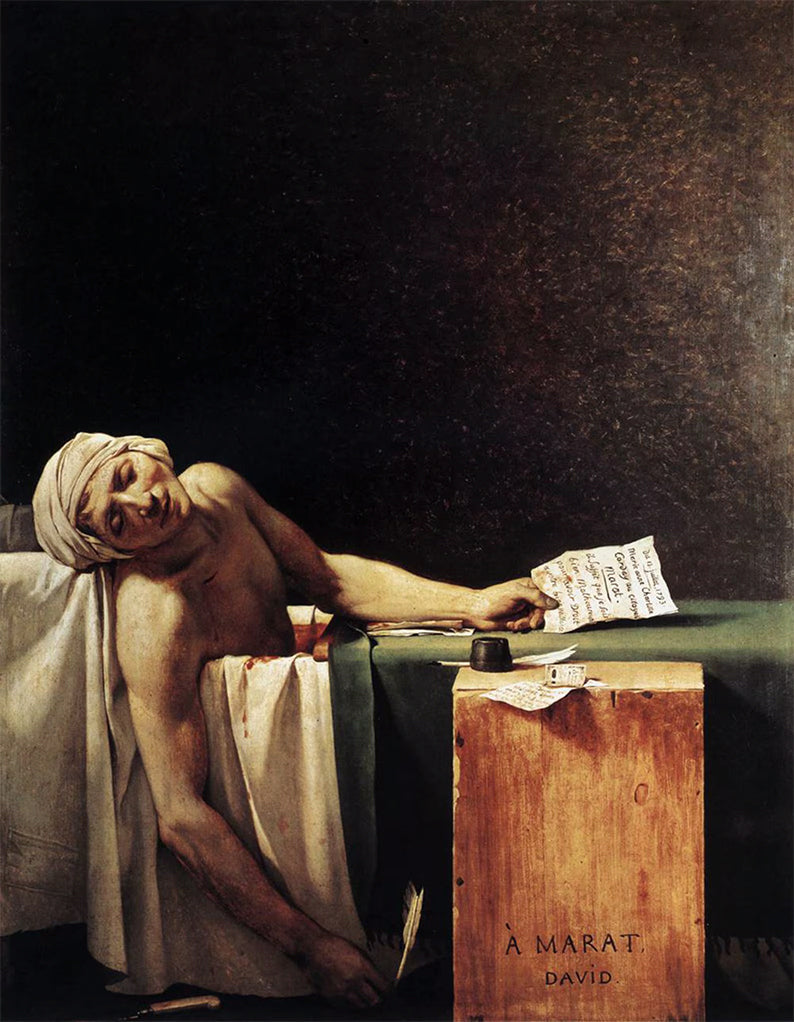
The Trouble with Political Art
The Louvre in Paris is home to a magnificent collection of art and on my occasional visits, I always find myself drawn to the "Death of Marat" by the French painter Jacques Louis David.
I had no idea who Jean-Paul Marat was, and to tell you the truth, I did not really care. For me, it was a wonderful and powerful painting. The presentation of the figure, dead in his bath, a quill resting in his limp right hand, a piece of paper in his left. A bloodied knife lies on the floor in a straight line from the bleeding wound in the dead man’s chest.
I enjoyed the artist's use of green and brown to dominate the work, the light and shadow on the figure's white flesh appearing real.
I was mesmerized by this painting. Crowds gathered by the Mona Lisa, not far from where I stood, but it was this unassuming and beautiful work that held my attention.
So what am I getting at? What I knew was Marat was dead in his bath and that he had been a writer, pretty obvious. Only in the last few years when I became curious about the French Revolution did I learn that he was a revolutionary scribe, quite the hot head, who spent a good part of his day in a bath to quell the discomfort from a skin disease.
During the excitement of the revolution, he had been a radical Jacobin who propagated the use of the guillotine to rid revolutionary France of her enemies. This gentleman who I had admired so in David's representation had a lot of blood on his hands, and his life was finally taken on July 13, 1793, by Charlotte Corday the anguished daughter of a man Marat had ordered put to death.
As for the artist, Jacques Louis David, He was a great painter of the Neo-Classical school. His paintings are often huge, portraying events in history and in revolutionary France as if they were plays recreated on a vast and beautiful canvas stage.
David was as well as being a great painter was also a revolutionary politician, and immersed himself in agitprop to glorify whoever was paying the bills at the time. After aggrandizing the revolution as a Jacobin radical, David morphed into a great supporter of Napoleon, who having taken power reinstituted slavery and crowned himself emperor. Even though the French Revolution had been left raped on the side of the road and forgotten, the former radical artist seeking a new patron became a sycophant for the Corsican general. The painting "Napoleon Crossing the Alps" is as good an example of a "man crush" as one could imagine in the world of art. The composition shows a strongly idealized view of the crossing that Napoleon and his army made across the Alps through the Great St. Bernard Pass in May 1800.
A splendid Napoleon posed on a wild steed, its legs raised in the air, before dashing into battle. The horse even seems to be getting into the vibe and overacting for the artist.
Napoleon and his campy "Crossing the Alps" was first commissioned by the King of Spain. The King of Portugal looking not to be outdone by Spanish royalty, commissioned the artist to paint another one for him. David went on to paint three more versions of the event for well-heeled patrons of the arts.
So what was I to do? My favorite painting in the Louvre was an idealized version of the death of a revolutionary thug with the words “guillotine” wetting his lips.
And one of my favorite painters was using his great talents to push myths and fill his pockets.
I do not mind that the artist was a total opportunist who made a fine living, it is just too bad he was able to create such extraordinary beauty from the painting of lies.
That is the trouble with combining art and politics. The visual image is not the best means of scratching the surface of an event and seeing the ingredients that went into the creation of what becomes history and knowledge.
While the artist glorifies the figure he is mythologizing, the viewer can marvel at the beauty of a work while swallowing a lie. One comes away from David's works with a warped sense of history, witness to the propagandizing of the arts in the hands of a master.